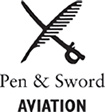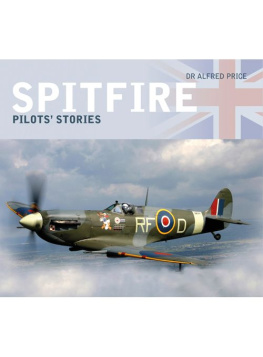ALSO BY DILIP SARKAR
Spitfire Squadron: No. 19 Squadron at War, 1939-41
The Invisible Thread: A Spitfires Tale
Through Peril to the Stars: RAF Fighter Pilots Who Failed to Return, 1939-45
Angriff Westland: Three Battle of Britain Air Raids Through the Looking Glass
A Few of the Many: Air War 1939-45, A Kaleidoscope of Memories
Baders Tangmere Spitfires: The Untold Story, 1941
Baders Duxford Fighters: The Big Wing Controversy
Missing in Action: Resting in Peace?
Guards VC: Blitzkrieg 1940
Battle of Britain: The Photographic Kaleidoscope, Volume I
Battle of Britain: The Photographic Kaleidoscope, Volume II
Battle of Britain: The Photographic Kaleidoscope, Volume III
Battle of Britain: The Photographic Kaleidoscope, Volume IV
Fighter Pilot: The Photographic Kaleidoscope
Group Captain Sir Douglas Bader: An Inspiration in Photographs
Johnnie Johnson: Spitfire Top Gun, Part I
Johnnie Johnson: Spitfire Top Gun, Part II
Battle of Britain: Last Look Back
Spitfire! Courage and Sacrifice
Spitfire Voices: Heroes Remember
Spitfire! The Experiences of a Fighter Pilot (by Sqn Ldr BJE Lane DFC, edited by Dilip Sarkar)
The Battle of Powick Bridge: Ambush a Fore-thought
Duxford 1940: A Battle of Britain Base at War
The Few: The Battle of Britain in the Words of the Pilots
Last of the Few: 18 Battle of Britain Pilots Tell Their Extraordinary Stories
The Spitfire Manual
Hearts of Oak: The Human Tragedy of HMS Royal Oak
CONTENTS
GLOSSARY
The following abbreviations are commonly used throughout the text:
AAF Auxiliary Air Force
AASF Advance Air Striking Force
a/c aircraft
ADU Aircraft Delivery Unit
AFDU Air Fighting Development Unit
AOC Air Officer Commanding
ASI Air Speed Indicator
ASR Air Sea Rescue
ATA Air Transport Auxiliary
ATC Air Training Corps
BEF British Expeditionary Force
CFI Chief Flying Instructor
CFS Central Flying School
CFS Central Flying School
CGS Central Gunnery School
CO Commanding Officer
CWGC Commonwealth War Graves Commission
E/A Enemy Aircraft
FAA Fleet Air Arm
FTS Flying Training School
ITW Initial Training Wing
JG Jagdgeschwader
KG Kampfgeschwader
LAC Leading Aircraftsman
LDV Local Defence Volunteer, the Home Guard
LG Lehrgeschwader
MOD Ministry of Defence
MTB Motor Torpedo Boat
MU Maintenance Unit
NCO Non Commissioned Officer
n/k not known
OTU Operational Training Unit
PDU Photographic Development Unit
POW Prisoner of War
PRU Photographic Reconnaissance Unit
RAFVR Royal Air Force Volunteer Reserve
RDF Radio Direction Finding, radar
RN Royal Navy
R/T Radio Telephone
RVT Riechverteidigung
SAAF South African Air Force
SFTS Service Flying Training School
StG Sturkampfgeschwader
UAS University Air Squadron
u/s unserviceable
USAAC United States Army Air Corps
WAAF Womens Auxiliary Air Force
The following German words and explanations may also be useful. In an effort to preserve authenticity, the original German is used throughout the text wherever possible.
Alarmstart Scramble, to take off urgently.
Eichenlaub The Oak Leaves, essentially being a bar to the Ritterkreuz.
Experte A fighter ace. Ace status, on both sides, was achieved by destroying five enemy aircraft.
Freie hunt A fighter sweep.
Gruppenstab Group staff.
Geschwader The whole group, usually of three gruppen.
Geschwaderkommodore The group leader.
Geschwaderstab The group staff.
Geschwaderstabschwarm The group staff tactical section.
Geschwader-gefechtstand Group tactical operations HQ.
Geschwader-maschine An aircraft belonging to the group.
Gruppe A wing, usually of three squadrons.
Jagdwaffe The fighter force.
Jagdbomber A fighter-bomber, or Jabo.
Jagdflieger Fighter pilot.
Jagdgeschwader Fighter group, abbreviated JG.
Kanal The English Channel.
Kanalgeschwader Fighter and bomber groups based on the Channel coast.
Kanalfront The Channel Front.
Kampfgeschwader Bomber group, abbreviated KG.
Kampffleiger Bomber pilot.
Lehrgeschwader Literally, a training group, but actually a precision-bombing unit, abbreviated LG.
Oberkannone The Top Gun.
Ritterkreuz The Knights Cross of the Iron Cross.
Ritterkrueztrager Holder of the Knights Cross.
Rotte A pair of fighters, comprising leader and wingman, into which the Schwarm broke once battle was joined.
Rottenflieger Wingman.
Riechverteidigung RVT, the organisation charged with the aerial defence of Germany.
Schwarm A section of four fighters.
Stab Staff.
Staffel A squadron.
Staffelkapitn The squadron leader.
Staffel/Gruppen Kommandeur The squadron/wing commander.
Stuka The Ju 87 dive-bomber.
Sturkampfgeschwader Dive-bomber group, abbreviated StG.
Vermisst Missing.
Each geschwader generally comprised three gruppen, each of three staffeln. Each gruppe is designated by Roman numerals, i.e. III/JG 26 refers to the third gruppe of Fighter Group 26. Staffeln are identified by numbers, so 7/JG 26 is the 7th staffel and belongs to III/JG 26.
The abbreviation Me is used throughout the text for Messerschmitt, although Bf is also correct. As Battle of Britain pilot Flight Lieutenant Keith Lawrence DFC said, however, To us they were simply 109s.
Rank comparisons may also be useful:
Feldwebel Sergeant
Hauptmann Squadron Leader
Leutnant Pilot Officer
Major Wing Commander
Oberfeldwebel Flight Sergeant
Oberleutnant Flight Lieutenant
Oberst Group Captain
Oberstleutnant Lieutenant Colonel
Unteroffizier Corporal (no aircrew equivalent in Fighter Command)
INTRODUCTION
During the twentieth century, aviation, and military aviation in particular, remained a very young science. The Wright Brothers, of course, had only made the worlds first powered flight in 1903. Just a decade later, aeroplanes were being used as war machines. Pilots were seen as extremely glamorous figures fighter pilots especially so. The general public avidly consumed tales of aerial derring-do during the Great War. Every nation had its favourite: in Germany, Manfred von Richthofen the fabled Red Baron; in France, Georges Guynumer; in Britain, Albert Ball. Between the two world wars aviation became even more alluring as the boundaries were pushed further still by adventurous aviators. A whole new generation of young men was inspired to follow in the footsteps of their august heroes.
This new generation of would-be fighter pilots was no stranger to war. Born shortly after the First World War ended they had grown up in the shadow of it barely a family of the major combatants escaped losing a loved one during the 191418 conflict and from 1933 onwards war with Hitlers Germany was an ever-present prospect. None the less there was no shortage of aircrew volunteers. By 1938, the RAFs bi-planes had been replaced by new monoplanes: the Hawker Hurricane and Supermarine Spitfire. To become a fighter pilot was the ambition of most volunteers, and for the majority of them to fly a Spitfire was the ultimate aim. As Battle of Britain pilot Ken Wilkinson said, If you were a fighter pilot then you were a cocky so-and-so, but if you were a Spitfire pilot then you were cockier still!


















